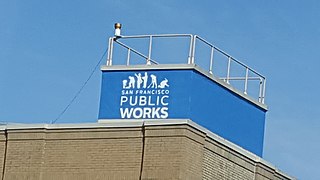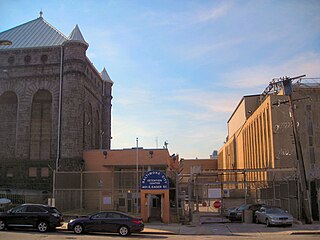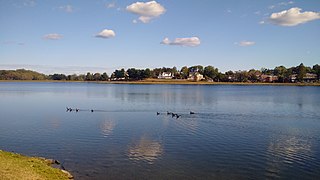
Laurel is a city in Maryland, United States, located midway between Washington, D.C. and Baltimore on the banks of the Patuxent River. While the city limits are entirely in northern Prince George's County, outlying developments extend into Anne Arundel, Montgomery and Howard counties. Founded as a mill town in the early 19th century, Laurel expanded local industry and was later able to become an early commuter town for Washington and Baltimore workers following the arrival of the Baltimore and Ohio Railroad in 1835. Largely residential today, the city maintains a historic district centered on its Main Street, highlighting its industrial past.

The Abbey Pumping Station is a museum of science and technology in Leicester, England, on Corporation Road, next to the National Space Centre. With four working steam-powered beam engines from its time as a sewage pumping station, it also houses exhibits for transport, public health, light and optics, toys and civil engineering.

The Anacostia River is a river in the Mid Atlantic region of the United States. It flows from Prince George's County in Maryland into Washington, D.C., where it joins with the Washington Channel and ultimately empties into the Potomac River at Buzzard Point. It is about 8.7 miles (14.0 km) long. The name "Anacostia" derives from the area's early history as Nacotchtank, a settlement of Necostan or Anacostan Native Americans on the banks of the Anacostia River.

COSI, officially the Center of Science and Industry, is a science museum and research center in Columbus, Ohio. COSI was opened to the public on 29 March 1964 and remained there for 35 years. In 1999, COSI was moved to a 320,000-square-foot (30,000 m2) facility, designed by Japanese architect Arata Isozaki along a bend in the Scioto River in the Franklinton neighborhood. COSI features more than 300 interactive exhibits throughout themed exhibition areas.

The Hyperion Water Reclamation Plant is a sewage treatment plant in southwest Los Angeles, California, next to Dockweiler State Beach on Santa Monica Bay. The plant is the largest sewage treatment facility in the Los Angeles Metropolitan Area and one of the largest plants in the world. Hyperion is operated by the City of Los Angeles, Department of Public Works, and the Bureau of Sanitation. Hyperion is the largest sewage plant by volume west of the Mississippi River.

The Los Angeles County Department of Public Works (LACDPW) is responsible for the construction and operation of Los Angeles County's roads, building safety, sewerage, and flood control. DPW also operates traffic signals and intelligent transportation systems, drinking water systems in certain communities, operates five airports, paratransit and fixed route public transport, administers various environment programs, issues various permits for activities in the public roadway, and has a Department Emergency Operations Center that works in conjunction with the County Emergency Operations Center operated by the Sheriff's Department. The department is headquartered at 900 South Fremont Avenue in Alhambra, California.

A combined sewer is a type of gravity sewer with a system of pipes, tunnels, pump stations etc. to transport sewage and urban runoff together to a sewage treatment plant or disposal site. This means that during rain events, the sewage gets diluted, resulting in higher flowrates at the treatment site. Uncontaminated stormwater simply dilutes sewage, but runoff may dissolve or suspend virtually anything it contacts on roofs, streets, and storage yards. As rainfall travels over roofs and the ground, it may pick up various contaminants including soil particles and other sediment, heavy metals, organic compounds, animal waste, and oil and grease. Combined sewers may also receive dry weather drainage from landscape irrigation, construction dewatering, and washing buildings and sidewalks.

Abel Wolman was an American engineer, educator and pioneer of modern sanitary engineering. His professional career left impacts in academia, sanitary engineering research, environmental and public health services, engineering professional societies, and journal publications. Wolman is best known for his research with Linn Enslow in the chlorination of Baltimore's municipal water supply, which has contributed to the distribution of safe municipal water supplies globally.

National Harbor is a census-designated place (CDP) in Prince George's County, Maryland, United States, located along the Potomac River near the Woodrow Wilson Bridge and just south of Washington, D.C. It originated as a 300-acre (1.2 km2) multi-use waterfront development. Per the 2020 census, the population was 5,509.
The Baltimore City District Courthouses of the District Court of Maryland are located at North Avenue, Wabash Avenue, Patapsco Avenue and E. Fayette Street in Baltimore, Maryland, and serve as the courts of first impression for the majority of residents in Baltimore City.

Medfield is a neighborhood located in north Baltimore, Maryland, United States of America. It is located to the north of the trendy Hampden neighborhood and south of affluent Roland Park neighborhood. Its unofficial boundaries are Coldspring Lane to the north; Jones Falls Expressway to the west; Falls Road/Hickory Avenue to the east; and West 41st Street to the south.

The Art Gallery of Hamilton (AGH) is an art museum located in Hamilton, Ontario, Canada. The museum occupies a 7,000 square metres (75,000 sq ft) building on King Street West in downtown Hamilton, designed by Trevor P. Garwood-Jones. The institution is southwestern Ontario's largest and oldest art museum.
The Baltimore City Heritage Walk is a heritage trail that links 20 historic sites and museums in downtown Baltimore, Maryland.

San Francisco Public Works (SFPW) is a governmental agency for the City and County of San Francisco in California. They are responsible for the care and maintenance of San Francisco’s streets and infrastructure. The department designs, builds, resurfaces and cleans streets; plants and maintains trees; designs, constructs and maintains city-owned facilities; designs combined sewers owned by San Francisco Public Utilities Commission; designs drainage facilities; conducts sidewalk and roadway inspections, constructs curb ramps, provides mechanical and manual street cleaning, removes graffiti from public property; and partners with the diverse neighborhoods in San Francisco. Public Works serves San Francisco residents, merchants and visitors 24 hours a day and seven days a week with a workforce of approximately 1,200 employees, as of 2009.

Baltimore is the most populous city in the U.S. state of Maryland. With a population of 585,708 at the 2020 census, it is the 30th-most populous city in the United States. Baltimore was designated an independent city by the Constitution of Maryland in 1851, and today it is the most populous independent city in the nation. As of the 2020 census, the population of the Baltimore metropolitan area was estimated to be 2,838,327, making it the 20th-largest metropolitan area in the country. When combined with the larger Washington, D.C. metropolitan area, the Washington–Baltimore combined statistical area (CSA) has a 2020 U.S. census population of 9,973,383, the third-largest in the country.

The Homewood Campus is the main academic and administrative center of the Johns Hopkins University. It is located at 3400 North Charles Street in Baltimore, Maryland. It houses the two major undergraduate schools: the Zanvyl Krieger School of Arts and Sciences and the Whiting School of Engineering.

The Philadelphia Water Department is the public water utility for the City of Philadelphia. PWD provides integrated potable water, wastewater, and stormwater services for Philadelphia and some communities in Bucks, Delaware and Montgomery counties. PWD is a municipal agency of the City of Philadelphia, and is seated in rented space at the Jefferson Tower in the Market East area of Center City, Philadelphia.

Baltimore City Detention Center is a Maryland Department of Public Safety and Correctional Services state prison for men and women. It is located on 401 East Eager Street in downtown Baltimore, Maryland. It has been a state facility since July 1991.
The North Avenue Market is a historic market in Baltimore, Maryland, located on North Avenue between Charles Street and Maryland Avenue. The market opened in 1928.

Lake Montebello is a reservoir located near Mayfield and Coldstream-Homestead-Montebello in Northeast Baltimore City in central Maryland. The lake was excavated and constructed in 1881, and nearby Montebello Filtration Plants 1 and 2 were completed in 1915 and 1928, respectively. The lake contains approximately 410 million US gallons (1,600,000 m3) of water, with a maximum storage of 606 million US gallons (2,290,000 m3). Today, the lake continues to act as a settling basin for what goes on in the filtration plant. A 1.3 mile bike and walking path lines the lake and are used as a recreational area for the surrounding community.

















